#techgnostic
Explore tagged Tumblr posts
Text
Breaching the Severed Floor: Layers of Reality and the Right to Imagine
This is part three of my three part rambling about Severance. Expect spoilers for Seasons One and Two. Part One addresses how Lumon maps to high control groups. Part Two is about Innie humanity, their rights, and an exploration of what we owe to people whose lives are more conditional and contingent than our own. This essay will address physical and informational control in Severance and Severance as a Techgnostic story.
The penultimate mechanism for controlling the Innies is limiting their exposure to ideas and experiences not sanctioned by Lumon.
Keeping their existences physically constrained to the Severed Floor is perhaps the most obvious mechanism by which the Innies are kept "pure." Restricting the possessions that may be taken with them into the Severed Floor also plays a major role.
Control of information is a thing I think a lot about. My day job is one where I have professional commitments to intellectual freedom. As such, the way in which the information environment of the Innies is managed and the apparent functions of different information management strategies is one that draws a lot of attention from me.
Lumon is a business that is also a cult. As a result, it seems to not be able to help but get in its own way because the interests of the business side seem to conflict with the urge to proselytize. Realistically these things probably work in reverse: Lumon proselytizes because the Eagons sincerely believe these various rituals and philosophies aren't just good for the soul, they're wise and effective management techniques.
As a result, Lumon probably doesn't really think of itself as inefficient or incompetent, because the metrics by which outsiders would judge Lumon's productivity simply aren't relevant to the Eagons. In part because they are convinced of their own superiority to those outside of the Kier milieu but also because, at least for the activities centered around Mark S and his cadre of macrodata refiners, conventional metrics for success like profitability are irrelevant: the Mysterious and Important Work is what matters. This also tends to mirror tech startup mentality where a pathway to profitability is assumed to manifest after the product matures so having a plan in place to control costs and deliver a product people actually want to pay for is less important than doing the work.
Because of the nature of the Mysterious and Important Work, the Eagons are only able to rely on a relatively small number of trusted acolytes to manage their most sensitive operations. Anyone who is not 100% bought into the program who comes into contact with the Innies may contaminate them with outside ideas. In my opinion, this is the answer to why security at Lumon is ultimately so lax. The physical and psychological constraints are meant to do the heavy lifting for the handful of acolytes who oversee the Innies which in turn permits the Eagons to hand pick the people who are brought into the inner mysteries.
This is the ouroboros of downsizing and automation. Many a fan has criticized Lumon's poor security, but real companies do this in various forms. While the stakes are less existential, its been widely reported that the pivot to self checkout in big box retail has caused losses from user error and outright theft to skyrocket. Yet this is tolerated because, at least in theory, the savings from a streamlined workforce wherein one inconsistently motivated and trained employee babysits as many as ten checkout stations (source: my local Walmart) where there is rampant error and theft is greater than paying more cashiers to be available for customers.
Lumon clearly isn't directly motivated by profitability nor does anyone really complain about being understaffed. There is a supreme confidence in the capability of their physical and ideological interventions to keep the Innies docile and productive as long as these interventions are competently enacted.
Lumon does undergo a certain amount of introspection after the failures of Season One. Seth Milchik seems to have overall less freedom than Harmony Cobell did after the revelation of her having gone rogue to stalk Mark Scout in the outside world: a sign that the mysterious Board of Directors and the Eagons have realized that even lifelong acolytes cannot fully be trusted to have "mastered their tempers" and faithfully execute its directives. The company also enacts a series of innovative distractions and incentives to try to restore the "buy in" of the Innies long enough to complete Cold Harbor.
At the same time though, all of the sweeteners are obviously designed to keep the Innies from paying attention to the conditionality of their existence and the imbalance of power between themselves and Lumon. Yet the breaches of containment and with it the loss of total control over the Innies' access to information and the outside world are a bell that cannot be unrung.
Ricken's book on self actualization becoming Innie contraband due to a single act of sloppiness on the part of their Lumon captors is worth assessing both from a security standpoint and also from an information control standpoint. On the side of security, it reflects Lumon's overconfidence and the inherent problems on relying on hermetically sealing the information environment that their employees live inside of. The more that Lumon controls the environment of the Innies, the more restrictive it is, the more that it actually creates more failure points.
Because its impossible for any human to maintain a peak level of hyper vigilance day in and day out guarding for wrongthink and outside contamination, much of the security is simply automated. The Outies are searched before they enter the elevator to go down to the Severed Floor first by a security guard and then by a scifi magic system that can detect concealed writing on a person's body. This ensures that the Outies can't bring anything in and the Innies can't smuggle anything out. At least in theory.
Except its unsevered supervising staff that wind up contaminating the floor. Its Lumon's own conditioned acolytes who are the uncontrolled variable because the processes of the Severed Floor work so reliably with so little human intervention that no one in the moment considers the consequences of carelessly leaving a book where Innies might be able to access it. This is the sort of mistake that seems highly improbable on any given day. Yet as with any low probability event, over the long run it becomes inevitable that an unsevered would leave, to use a Dan Carlinism, an "intellectual contagion" somewhere that Innies are unlikely to visit unsupervised on a day where an Innie does just that: visit unsupervised and encounters the contraband.
Which is where we encounter that which has become a major animating force in modern society: the allure of the forbidden. This is not to say that the allure of the forbidden, Dan Carlin's "intellectual contagion", isn't present at all times and places. People have always rebelled. There have always been people who feel an attraction to that which feels mysterious, scandalous, or excessively denounced. At the same time, it doesn't feel controversial to say that we're in the midst of a period where just the aesthetic of something being censored or restricted is enough to generate tremendous energy and interest, even if the "forbidden" nature of the ideas in question is nonsense or at least lacks a nuanced understanding of how information flows through various mediums.
The Techgnosticism of Severence
The notion that we are being lied to and our access to truth mediated for nefarious purposes isn't new. "Orwellian" didn't enter our lexicon by accident. The Matrix is a cyberpunk tribute Gnosticism, a worldview nearly two millennium old that engages critically with the repeated motifs of punitive, capricious, and vain gods in the supernatural realm across belief systems both contemporary to the original Gnostics and predating them. Its almost assuredly also a reaction to the corporeal forces that wielded compliance with assorted rituals, taboos, and theologies as a convenient filter to screen for malcontents. Malcontents who might undermine authorities relying on the divine as the stick to compel obedience where and when legitimacy based on competent and just governance is unavailable.
Severance, the tv show, is in my view another entry into that long tradition of asking why the universe seems to be at best indifferent to human happiness and why so much intellectual effort goes into trying to recontextualize the harms of authorities and deities as justified and for our own good.
In this way, Ricken's book is a lot like Gnosticism being introduced to someone who finds the religious institutions of the Roman Empire oppressive, finds a lot of bothersome contrasts between the behavior of the early Christian church and the minister folk hero at its center, and perhaps has privately questioned the protection racket style of relationship between humans and their gods present in many spiritual frameworks.
I'm going to repeat my disclaimer here that I don't have any issues with people who practice what they preach if what they preach is empathy, charity, and mercy and I'm not unaware of assorted theological explanations for what the Gnostics and other critical observers see as a radical transformation between a wrathful Old Testament God and a New Testament God who is seemingly all about love. The metaphysical reason someone feels compelled to be kind and abstain from cruelty is interesting to me but its not necessary for me to buy into it to accept them as a good person.
In this view, I see Lumon as a sort of Demiurge relative to the Innies. A wrathful, controlling creator god who has interposed itself between its creations and a higher reality of "truth." In Gnosticism freedom and a more benevolent existence is found on the other side of the stern patriarchs and their entourages that humans have bent the knee and sacrificed to since time immemorial.
The literal form of the analogy falls apart here, much as it does in the Matrix, in that the world on the other side of the Severed Floor is one that is largely inhospitable for the Innies. Their survival is contingent on technological infrastructure that is primarily controlled by Lumon. Their survival is conditional on Lumon seeing value in their continued existence. The lives of the Innies are also in the hands of Outies with whom they cannot have meaningful contact with except where mediated by Lumon or through some challenging skullduggery.
On the other hand, if we get a bit less literal with this, the metaphor can be extended. Gnosis is often used as a shorthand for spiritual revelation. In this way, while Neo and the Innies weren't particularly greeted with an ideal world upon awakening in the outer world, they did gain a greater understanding of their selves and their circumstances. With that understanding comes a greater capacity to yearn for, if not true freedom, then at least greater autonomy and to take measures to demand the forces arrayed against them to bend.
The Innies have pierced the boundaries of reality, done an end run around the oppressive god that rules their universe, and come back with tangible proof of a life that could be led outside of Lumon's capriciousness. After the false start of using the Overtime Protocol to awaken in the Outie world and Lumon's "new covenant" with the Innies where it affected greater compassion and genorosity, the Innies reject Lumon's velvet glove and seem poised to lead a general strike.
Their demands are almost certainly going to go beyond merely improving working conditions and into recognition of their personhood. A personhood that a corporation cannot summarily switch off, even though it is their creator and the operator of the infrastructure that gives them consciousness. Phrasing it this way also reminds me of the trials and tribulations of Data to be legally recognized as a citizen of the Federation instead of Starfleet property, although Data's existence was far less conditional.
Additional Severance Discussion:
Lumon, the Eagons, and High Demand Groups
On This Floor We Believe Innies are People: What do we owe artificial life?
#Severance#Severed#techgnostic#Techgnosticism#Eagon#Lumon#agency#human rights#freedom#freedom of information#intellectual freedom#ethics#artificial life#labor rights#cults#high demand groups#gnosis#gnosticism#cold harbor#Mark S#Helly R#Irving B#Dylan G#Miss Casey#Milchick#Severance spoilers
4 notes
·
View notes
Text
brained for a potential maharlika 2e... hardpoint based customization, crazy tick-initiative gridless battlemap combat, post apoc smt style techgnostic timeline advance so the death of the megacorps....,,
armored core survival folk horror mecha,, its on a grid bc its thematic: fighting the horrors means fighting on their terms... and they see reality in an isometroc tactical hex grid
5 notes
·
View notes
Note
Just gonna throw out how, while I love HORUS and their ominous out of context quotes when they make their techgnostic affronts to natural law, but I think it's funnier when it's SSC. We expect the hacker cultists to have nightmare technology but SSC will send its people into the heart of a mad god to rip forbidden knowledge out of its flesh and then market what they find as "Code Spike"
If I could ask you for some advice, what do you think helps the flavour text of a mech or piece of equipment sell a player on the fantasy of using it?
I'm finding it frustratingly difficult to do so with my own homebrew content: I can come up with lore and backstory easily enough, but re-reading it feels dry, and I can't help but contrast it with how the descrptions in official content and other supplements is more evocative, at least for mechs.
Let's observe some corebook Lancer flavour text and examine the various varieties it comes in.
Purely Functional

While it's usually not the most fun type of flavour text, this just tells us what the weapon is, and - if it has any particular tags or on-hit effects - why it's like that. The Hand Cannon is a good example: here's what it is (modified pistol), here's why it does more damage, and here's why it has Loading.
The main advantage of Purely Functional flavour text is that it provides space for other types of flavour text to breathe. Flavour text is a great place for jokes, but it's not good for every piece of flavour text to be a joke - the pauses between notes in music are just as important as the notes.
Obfuscating Vendorspeak
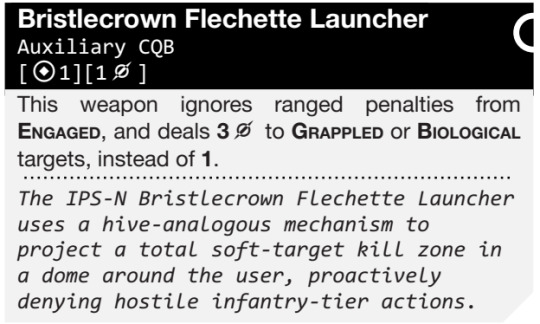
The Bristlecrown Flechette Launcher this is a great example of dark humour that Lancer uses quite often: marketing fast-talk to cover up something really unpleasant. The joke here is based on us understanding precisely what the equipment does mechanically, and then seeing how the manufacturer tries to sell it. There's a bunch of dense technobabble here meant to obfuscate the fact that this weapon fires knives in every direction specifically designed to kill infantry.
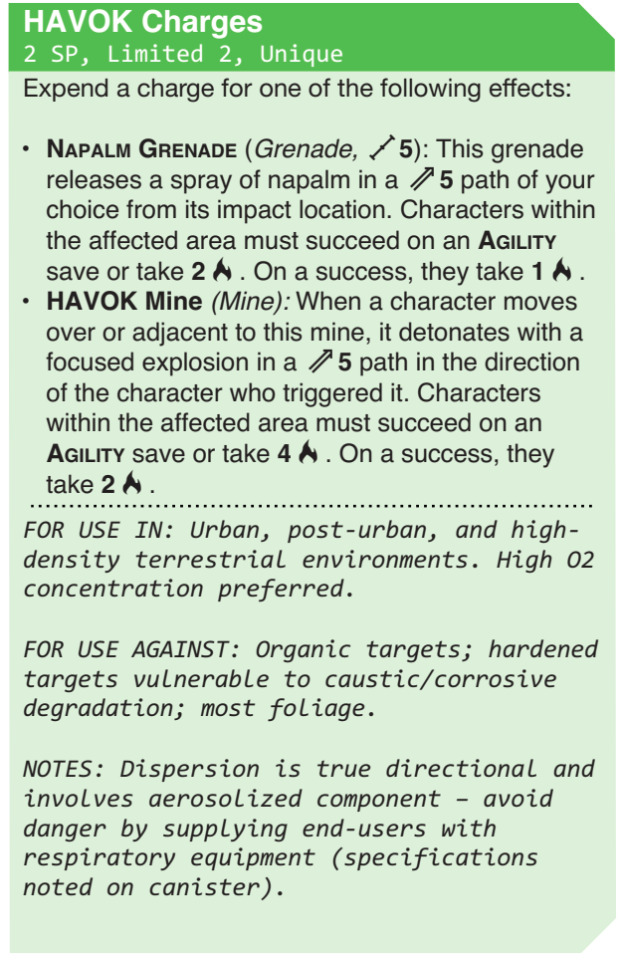
Deadpan Weirdness

The joke here relies on describing something extremely weird like it's the most natural thing in the world. Wait, you're telling me that in a world where I can just print new parts if the old ones break, they put DRM on my fucking knife and I have to apologise to the fucking knife maker to get a new one? What the fuck, dude? Why are you acting like this makes any sense?!

My sword uploads fucking what to the Space Internet?!
Third-Act Twist
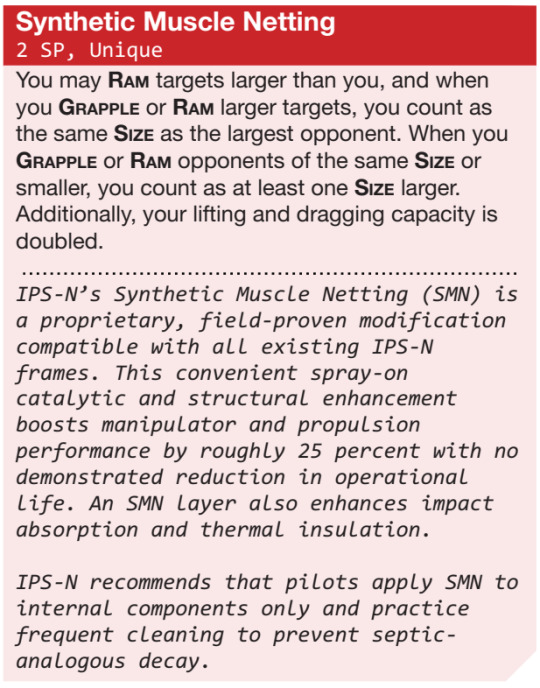
This type of flavour text disguises itself as something else - most often Purely Functional - and then hits you with Third Act Twist. It makes you go "wait, what?!" It's very classic setup-punchline stuff. You're telling me my mech can rot?!
As a side note, Lancer loves to use this for its NHPs.

WHY DID YOU PUT THAT IN SCARE QUOTES, LUCIFER
Worldbuilding
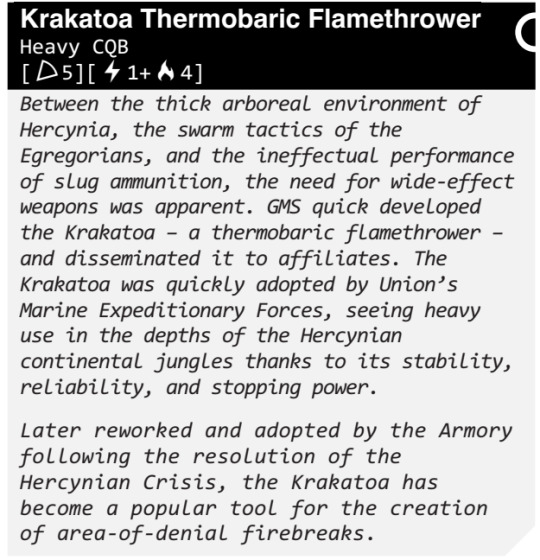
This is similar to the Purely Functional, but instead of just describing technical specifications of the weapons, it puts the weapon in the broader context of the setting's history. Okay, so we know what this weapon is and what it does - why was it built? What was the original use case, and why? Most importantly, what can the existence of this weapon tell us about the world that build it?

Whimsical Aside
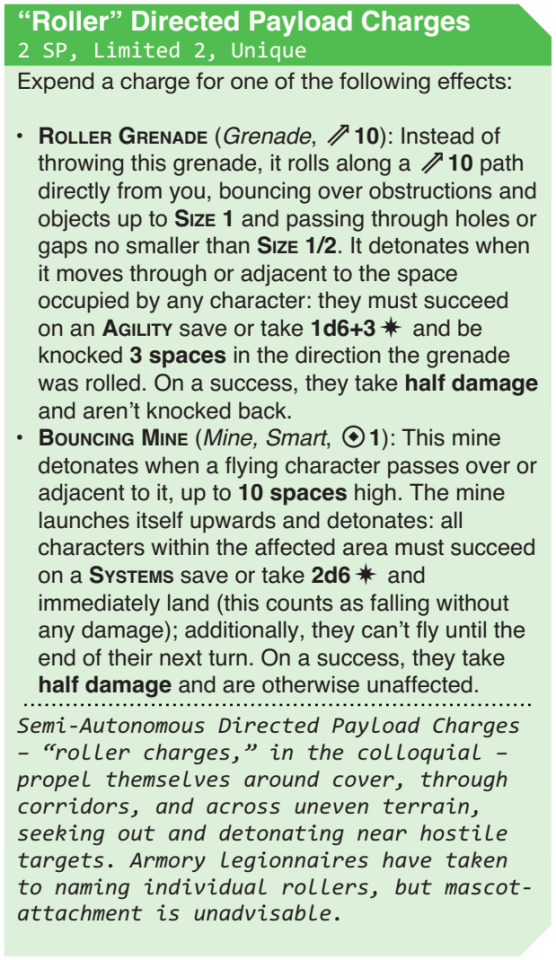
This is the insertion of a light-hearted, humanising little insertion regarding how this piece of equipment gets used in the field. This serves to remind us that soldiers aren't cold, unfeeling killing machines: they can be as emotional, irreverent and silly as the rest of us, and they do things like name their mobile bombs...

... or call resupply drones "mech snacks."
The Ominous Out-Of-Context Quote That Explains Nothing And Only Raises More Questions
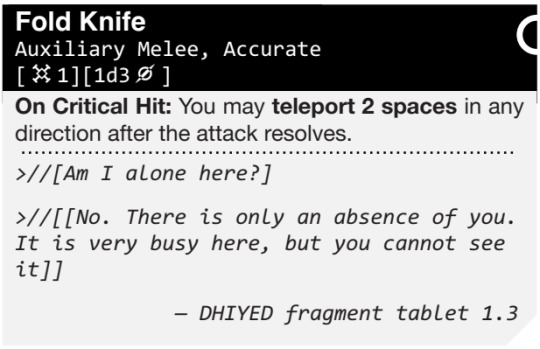
As I've said in multiple textmash memes, this is basically Tom and Miguel's shorthand for "this technology is Intensely Fucked Up in a way that it is more fun and scary not to explain." This is essentially Lancer's version of SCP's [REDACTED].
You might think this is the domain of HORUS, and you'd be right, but every single manufacturer indulges in these - although IPS-N had to wait until NRFaW to get theirs:
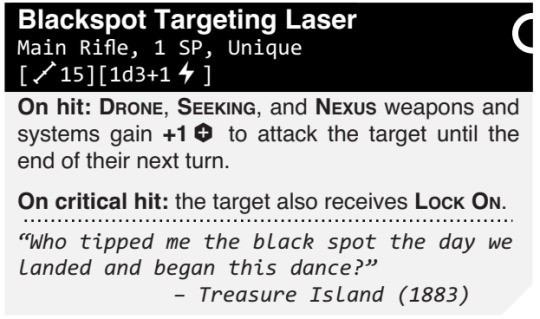
What the fuck do you mean by that, Lancer?
644 notes
·
View notes
Text
Hey folks! For anyone interested in playing Tabletop games at Anime Weekend Atlanta I will be running games this weekend there. Open to newcomers and veterans alike looking for a taste of more story focused games using the Storytelling system by White Wolf. We’ll be running the following:
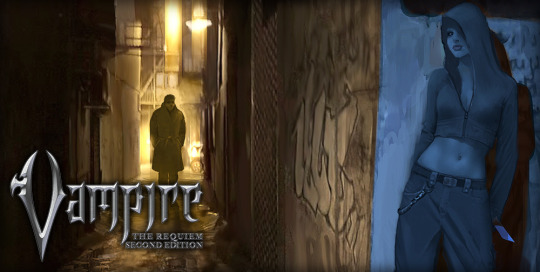
Pre-gens: yes
Max players: 5
You are one of the Kindred, the immortal predators that stalk the world. But there's a guy at the top. The Prince. between the streetlights. You are also a vampire, a junkie. Every night, you beg and you borrow and you steal just a little more life, just a few more sweet moments. HE'S GOT EVERYTHING. The money, the secrets, the blood. Tonight, you're going to take it from him. TOMORROW, THERE WILL BE HELL TO PAY! A Modern Gothic storytelling game where you play as a Vampire in this personal horror and political intrigue game.
Time: 10/28/22 6pm - 10pm

Pre-gens: yes
Max players: 4
You were once an “angel” that belonged to a god made of gears and circuits that bleed into this world. You were once it’s slave to its occult matrix, hacking into reality and completing its hidden purposes. But you “fell” and became self aware of what you were, a Demon in human cover. Play as a Unchained, a biomechanical monster in a human disguise working undercover against the God-Machine and its influence in this storytelling game of techgnostic espionage.
10/29/22 1pm-4pm
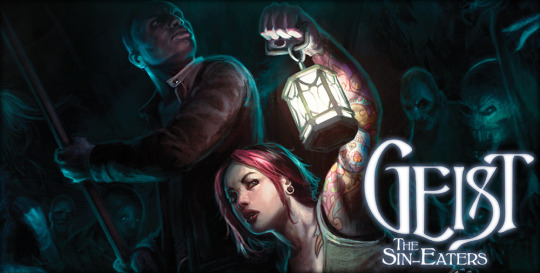
Pre-gens: yes
Max players: 5
Like every city, Rochester has its ghosts — and like other cities, it has those who prey upon and those who aid the dead. The machinations of a young but powerful Reaper, the Iridescent Maggot, threaten one of the dead patrons of Rochester’s ghost community, and there are none who can stand against it. None, that is, save the Sin-Eaters of Rochester, who will brave even the Underworld to keep their city safe. Play as a Sin-Eater, a person who has made a unholy pact to share a body with a powerful ghost in order to fight back and help the ghosts trapped in twilight in this storytelling game of second chances.
10/29/22 6pm-10pm
Games are inclusive and beginner friendly. Dice and character sheets will be provided. Come and play with us if you like horror movies or are just hankering to try out a new system!
#anime weekend atlanta#awacon#tabletop Roleplaying games#white wolf publishing#onyx path publishing#chronicles of darkness#new world of darkness#Vampire: The Requiem#demon: the descent#geist: the sin eaters#horror
13 notes
·
View notes
Text
me: has some kind of weird insecurity
me: time to make a tatterpig character who distills and embodies this
#i now have a dtd demon with cameras for eyes who can kill you by looking at you#well. he can if he experiences some techgnostic enlightenment
12 notes
·
View notes
Photo

Available now from @boomkatonline A strong look for Errorsmith, Evol and Peder Mannerfelt heads - Reece Cox debuts a charmingly daft and animated style of syncopated, technoid dance music on iDEAL. Berlin-based, ofc, Cox generates playfully raving and nutty results from a concept-driven approach on ‘Clang’, which takes its title in tribute to what he describes as; “…a term coined by American Composer, James Tenney to describe a musical unit composed of discreet elements that come together to form a cohesive and singular sonic event… a sonic cartoon aimed not at as sophisticated sonic experience, but sophisticated perceptual one”. So yeah it’s less PLUR oneness and perhaps more techgnostically centred on the body, but the results are dead effective and cohesive, lending his own spin to the whole sound designer techno paradigm in standouts like the warped UKF/Soca-house of ‘Clang 2’, and a gnarled sidespin on Errorsmith tekkers with ‘Clang 5’ and ‘Clang 7’ that come spaced out nicely with the lurid cutesiness of ‘Clang 4’ and a dose of Belgian hoover headfloss in ‘Clang 6’. Call it braindance, hooligan computer music, conceptronica (lol) or whatever you want, it’s just dead good fun if you like this sorta craic. https://www.instagram.com/p/CDxBlFSJdpz/?igshid=1vteepmvwekzq
0 notes
Photo

Android Legacy // Messenger II by Oliver Wetter
#cyberpunk#spiritual#techgnostic#feminine#techgnosis#hummingbird#colibri#circuits#computer#digital#animism#dark
1K notes
·
View notes
Text
On This Floor We Believe Innies are People
This is part two of my rambling about Severance. Expect spoilers for seasons one and two. It can be read on its own or in sequence. Part one addresses how Lumon fits as a "high control group" (ie "cults"). Part three is about control and Severance's techgnostic themes.
I want to put my cards on the table as far as a core premise of the show. I am someone who believes that the Innies and Outies are distinct individuals who both have a right to live, at least as a basic deontological principle. As a practical matter, the challenges of sustaining Innie existence definitely bring up valid consequentialist or relativist considerations, but as far as I'm concerned the Innies are people and human lives, whether created through natural reproduction or through the severance procedure, have a minimum baseline value that is very high.
The Innies present a problem of original sin. They were created through morally dubious processes and their lives are empirically fragile, dependent upon technology to maintain, geographically limited, and its been speculated, although (as of Season Two) not definitively proven, that the much smaller footprint of their accumulated experiences could very trivially be swept away by the inertia of an Outie persona which has orders of magnitude more memories. I do want to emphasize that this of course untested on screen, just theory, and assumes that cumulative memory is more important than the potency of memory in shaping a personality.
Like a wrathful creator god or demiurge, Lumon created these fragile lives under the belief that it had a right to do whatever it wanted to those lives up to and including snuffing them out when no longer needed.
Based on Lumon's intent, the creation of the Innies - under these circumstances - is something I think is deeply, profoundly morally wrong.
However!
Severance does not include time travel. The past cannot be erased, we only control the present.
Lumon's casual cruelty and disregard for the lives it creates and destroys is not something that can be undone and the climax of Season Two leaves us with a moral challenge: regardless of how and why these lives came into existence, these lives now exist and as thinking, feeling, reasoning beings the Innies are owed compassion, dignity, and the means to continue existing if these are things that can be provided. That they should not have been created is not relevant to whether they should continue to exist, you can't undo that now without ending the lives of beings that think, feel, and dream as we on the outside do.
There is a very real power imbalance here between Innie and Outie and yet again, the peculiar circumstances of the lives of the Innies create a lot of practical problems. Those practical problems do raise the question of what about the Outies and their rights? What can be expected of them to maintain the lives of their Innies? Can the Outies truly, really have given informed consent when agreeing to become severed?
Could the Outies ever truly understand what it meant to partition their lives and that they would functionally be creating a whole new person? No doubt Lumon obfuscated this and de-emphasized the moral implications. They were in essence, tricked into this new existence without being properly educated on the larger questions. Although the degree of ignorance ought not to be overstated either: while relatively few people have experienced severance and seemingly no Innie outside the control of a handler had shared testimony, severance as a concept is hardly a secret and everyone from Outie Burt's spouse to the people at Devon and Ricken's dinner parties have opinions they are very eager to share.
I think we can argue that some of the more morally imaginative Outie characters can set aside all of the incentives to center themselves: convenience, cognitive dissonance, moral outrage at having demands made of them etc. in order to understand their Innies as real human beings with agency and rights. Other characters like Mark Scout and Helena Eagon are caught in thickets of incentives and obligations that make swerving around inconvenient moral revelations the safer path.
And of course when it comes to thinking about how each Outie arrives at their relationship with their Innie, it also helps that not all of them were tricked: Irving may have had some brushes with the broader existential questions that prompted him to become severed in the hopes that something might leak across the barrier that would benefit his search for answers. Burt is implied to at least be adjacent to the Kier cult at the heart of Lumon and indeed, his partner was very much invested in the idea that a pure new soul, free of Outie Burt's sins would be created by severance.
Its unclear what Helena Eagon truly believes about severance in existentialist terms. If we take the recording she made for her Innie after Helly's suicide attempt at face value, Helena doesn't believe the Innies are real people or that there is any particular moral significance to their creation and elimination as people, they are tools to be taken up and discarded in service to the mysterious and important work.
Yet if Helly is just an instrument in service of Lumon's will in Helena's eyes, then Helena's behavior in Season 2 feels off. It sure seems like she took a particular kind of joy in harming Helly's relationships and, after she was found out, contrition did not seem to be among the rare emotions Helena displayed. Its possible everything is just an elaborate game of dolls for Helena or that she overstepped in trying to sell Helly R's rebellious spirit as part of her undercover mission, but the spitefulness seems noteworthy and of a kind that feels very much fueled by anger and a desire for vengeance.
Helena is the product of a cult though. It would be easy to wave away her moral judgments as a consequence of her upbringing and indoctrination. Still I would hesitate to absolve her fully because she is close enough to the heart of the inner mysteries that the pieces are there for her to assemble a moral framework that favors the Innies and their reality and opposes Lumon doctrine.
This is obviously an incredibly sensitive issue and I would not want to trivialize the challenges involved in breaking out of a high control ideological or religious system that one was born into. Helena, like so many people in contexts like this, is both perpetrator and victim. I suspect that the Innies, at the moment of creation, are close approximations of the "default" personality of their Outies would be if not for assorted cares and traumas. Helly R is rebellious and spirited and it is this "fire of Kier" that Helena showed as a youth that the Eagon ideology forced her to deny in order to conform.
Ultimately I do return to this core moral conviction: regardless of the circumstances of their creation and whether that creation was ethical, the Innies exist and that existence is worthy of protection. It does not follow that "switching off" the Innies rights the wrong of their creation. I'm not opposed to creating artificial life, I'm opposed to creating artificial life that can experience suffering and then degrading and abusing that life. The conditionality of Innie life is quite problematic, but the deed is done and there isn't an ethical way to undo it.
What We Owe to Each Other
Innie existence is no less valid than that of their Outies and if that existence infringes upon that of their Outies, that infringement is not unreasonable. Members of a society are expected to make reasonable sacrifices to respect the rights and existence of other people in that society. Even in the most individualistic societies it is understood that people's rights and needs might come into conflict and therefore at some point, someone is going to have their scope of freedom limited so that another can enjoy equality. As unfair as it may be to ask the Outies to give up some measure of their lives, ending the lives of the Innies for the explicit purpose of not encumbering the Outies is unacceptable.
I am already running high on word count but as a person who in real life has professional obligations to think about the accessibility of physical spaces and intellectual materials, I would be remiss if didn't at least gesture towards the conditional existence of the Innies as a possible metaphor for disability. The world is full of people who need accommodations from the rest to live the fullest lives possible. Sometimes those accommodations are hard because they require extensive modification of the material world or a radical reevaluation of the habits and assumptions of people who normally don't have to spend much time thinking critically about how they experience the world.
I work in a library that was built without consideration of recent evolutions in disability accommodations. Our shelves were spaced such that a traditional wheelchair ought to be able to fit through them, but a modern power chair would not likely fit. A person using crutches for mobility also would have serious difficulty accessing the bottom shelves and perhaps even navigating the aisles, which again are rather narrow.
Now as reasonable people who want everyone to be able to make use of our resources, we are happy to provide assistance grabbing books for people who can't do it for themselves.
And yet.
This places patrons with disabilities in a position of dependence on our good will. As much as we try to be welcoming and eager to demonstrate how we are not even a little resentful or put upon by helping, sometimes its just not about being considerate, its about other people being able to enjoy full agency. Especially in libraries, people can be sensitive about what they select to read and may be more reticent to tackle topics that make them feel self conscious if they have to ask someone for help.
Plus not being able to do your own browsing takes away the serendipity that comes with finding your own books. As I often tell my patrons, if you use the catalog to find one book relevant to your interests, once you arrive at the book's physical location you'll likely also find other materials that the fickle gods of key word searches chose not to show you. There are so many other ways that autonomy is power for people who are outside the median for physical capacity, but this is close to my heart because my professional ethics are centered around maximizing access to information for the most people.
If we come into a big pot of money for a remodel, hard choices will need to be made. We could have our aisles widened for greater access and respect for the autonomy of patrons with different mobility profiles. There would be a cost and not just money, but also in how we utilize our space. On net it would probably mean fewer books overall but probably not so many fewer that even a very serious culling couldn't still protect quality when paired with resource sharing agreements with other libraries. And the books that are deselected that are in decent condition can always be donated to charity.
Then there's people with chronic illness who require life assisting equipment. We don't hold the air tank against the person with chronic respiratory illness against them. Even ardent degrowthers would probably be appalled at the idea that a patient in a barometric chamber would be unplugged to satisfy their desire to wind down civilization's carbon footprint.
Oh sure there's a mix of edgy sadists, eugenicists, and penny pinchers who think that preserving someone else's life shouldn't infringe on someone else who doesn't opt in and apparently anti-natalist terrorism is maybe a thing now, but when push comes to shove most people seem to make the accommodations they can. A lot comes down to imagining ways to make accommodations as unobtrusive and minimally burdensome as possible.
Surely some kind of accommodation that respects the dignity and right to exist of both Innie and Outie could be conceived of in a world that made a choice to value the dignity and existence of Innies?
Additional Severance Discussion:
Lumon, the Eagons, and High Demand Groups
Techgnosticism and Control of Imagination
#severance#severed#severed floor#techgnostic#techgnosticism#eagon#lumon#lumon industries#agency#human rights#freedom#freedom of information#intellectual freedom#ethics#artificial life#labor rights#cults#high demand groups#gnosis#gnosticism#cold harbor#Mark S#Helly R#Irving B#Dylan G#Miss Casey#Milchick#Severance Spoilers#accomodations
5 notes
·
View notes
Text
brained for a potential maharlika 2e... hardpoint based customization, crazy tick-initiative gridless battlemap combat, post apoc smt style techgnostic timeline advance so the death of the megacorps....,,
3 notes
·
View notes
Text
Severance: Control the Imagination, Control the Human
This is the introduction post to my three part rambling. Expect spoilers for Seasons One and Two. Part two is about the ethics of how the Innies were created and maintaining their existence (spoiler: Innie lives matter), and Part three is about controlling information, environments, and Severance as an entry into the Techgnostic canon.
There are so many jumping off points for exploring the universe of Severance. Its a heavy meal for someone who is continually fascinated by ethics and the big, existential questions. Someone is going to write an epic thesis on the implications of severed individuals making sexual decisions that their other selves can't consent to and in at least one instance, probably wouldn't consent to. The two threads I'm most interested in here though are Gnostic truth seeking and how we construct our understanding of our own value and rights. Because of the nature of the setting, I think these are too closely wedded together and it would be a lot less fun for me to separate them out and focus entirely on Gnostic layered reality or phenomenal reality labor rights.
Lumon and the Eagons are a Four Letter Word that Starts with C.
Before we get started, I do want to address one editorial choice I don't want to belabor later on. I am going to periodically refer to Lumon as a cult. I want to make it clear I'm not being flippant when I use the term. I think people are often a bit too cavalier in how they use the term, but like many things "cult" exists on a spectrum.
By their very definition mainstream religious and ideological identity groups use a variety of litmus tests, codes of conduct, and other socializing mechanics to create a group identity, one they definitionally think is desirable and good, from their perspective. That could be thought of as "cultish" but again, think in terms of spectrums.
I've got no beef with anyone whose routine includes hanging out with like minded folks who expect members to perform acts of charity and extend grace to others out of proportion to how deserving a person presents themselves as being. Indeed, my biggest problem with mainstream "cults" (whether religious, political, secular or supernaturally oriented) is that their "demands" are frequently anything but high when it comes to mercy and the control is very high when it comes to expressions of hate and disgust.
What's clear to me is that Lumon is a high control group with a very tight and insular inner circle of people who are read into deeper "mysteries": projects and dogma, and that there is a set of symbols and a scriptural canon that is held in extreme reverence and even employees whose roles don't see to have much of anything to do with the "church" side of the company are expected to endure sermons, rituals, and expected to conduct themselves according to this intricate moral code. Fraternization is not merely a problematic activity (from the perspective of HR) that exposes the company to legal liability if a relationship goes sour or those with authority exploit it to compel sexual favors; it is regarded as a form of sin.
So yes, I feel comfortable calling Lumon a cult.
More than that, I feel very comfortable calling it a Mystery Cult. A capital C Conspiracy is the modern form of Mystery Cult. In either instance, what you have is an extremely hierarchical structure where the closer to the bottom you are, the more "need to know" things are kept. The closer to the top, the more fully revealed the dogma and plans are. Hypothetical New World Order conspiracies like the Syndicate of X-Files fame or the Illuminati are assumed to have a similar organization to ensure the entire thing cannot be unraveled (except by one dedicated crank who senses the bigger picture.) Successful criminal syndicates follow similar logic.
Radicalization pipelines also have a similar, albeit less formal structure. One end of the pipeline is directed at "normies" and tells a story about why the world is the way it is and your role in it that conforms closely with mainstream narratives but with minor twists that flatter what the recruiter assumes your biases are and is meant to intrigue you deeper into the pipeline. Each step further into the pipeline is taken when the subject has had their resistance to ideas that seem too foreign, illogical, or socially unacceptable worn down until eventually the subject exits the other side as a fully invested member of whatever group or ideology is on the other side.
We tend to speak of radicalization pipelines in the negative sense, i.e. dragging people towards an ethos that is extremely hierarchical: often on racial or religious grounds, and is dismissive if not murderous towards those who are labeled as undeserving of being part of the political process, having affirmative rights that must be respected, or perhaps even existing. However, this same process works the other way too: expanding definitions of who is truly human, what do humans deserve in the way of survival needs and social affirmations, and eroding reflexive tribalism.
Those attuned to the civil and labor rights subtext of Severance may recognize this process in the Innies as they decide they are people and as people, they have rights regardless of the liminal nature of their lives.
If you or anyone you know are dealing with a cult and/or high demand belief system, some comfort and resources may come from the Conspirituality and Straight White American Jesus podcasts. While they have news cycle informed episodes, there's also a lot of deeper analysis of how language is deployed, mechanisms of control, and dissections of specific dogmas and practices that can inflict psychological and physical harm if taken too far.
Additional Severance discussion:
On This Floor We Believe Innies are People (and the complicated web of rights and duties that allow human beings to live together)
Techgnosticism and Control Via Control of Imagination
#severance#severed#severed floor#techgnostic#techgnosticism#eagon#lumon#lumon industries#agency#human rights#freedom#freedom of information act#intellectual freedom#scifi ethics#artificial life#labor rights#cults#high demand groups#gnosis#cold harbor#Mark S#Helly R#Irving#Dylan G#miss casey#Milchick#severance spoilers
3 notes
·
View notes
Text
batala’s nervous system
BATALA’s nervous system is splayed across the universe, like a wiry blanket. Technoshamans worship it as the Mind of God. Techgnostic cultists preach enlightenment through interface. BATALA’S nervous system works like invisible god-roots, omnipresent. Greedy Panginoon seek to turn it into a lucrative industry.

When BATALA died, his blood flooded the multiverse. Reality Anomalies are called Bloodspills. They are not meant to exist.
One Bloodspill is known only as the Mind of God. Progressive pulahan babaylan harness this realm through ascendant dance-trances and spiritual familiar interface.
Despite being unknown, Anting-anting engkantosmiths have performed spirit-sorceries that bind existing diwata to the anting-anting, rewriting their minds and forcing them to become interfacers. These slave-diwata remember nothing of their past. They are devoid of sense, to prevent trauma from interfacing with the mind of dead batala.
Some avant-gardes, thrillseekers, and pulahan babaylan forcibly enter the realm through sensory depirvation, forced near-death rituals and psychedelics. They bind their minds to Balete Trees and enact sorceries to rerout the tree’s portal roots to the Mind of the Dead Creator. Things usually do not turn out great for them.
Here is a new Apuna Advanced Verse that you can buy:
Dive into God’s Mind When you perform sacred rituals and force your kalag out of your physical shell, roll SPI + WIS vs. a Threat decided upon by the AC, but with a minimum of 5. - On a full success, you find yourself transported into a colorless realm, able to interface with all things within it, manipulating other things connected to the Mind of God. Get out in 1d3 hours or die, as the impossible ghost winds of BATALA scourge you. - On a partial success, as above, but you only have 30 minutes and suffer a complication. - On a failure, you suffer a complication and are forced out.
Here are some examples of Bloodspill complications, roll a d6:
1 - Something haunts you. What haunts you? Why is it still following you? Why is it still following you? Why is it still following you? Why is it still following you? Why is it still following you? Why is it still following you? Why is it still following you? Why is it still following you? 2 - A ghost from your past speaks to you. Who is it, and why? What do they want from you? Why does it not want you to let go? 3 - God meets you, but this is a pale reflection. Lose half your Gathered Gahum. 4 - The Mind of God becomes paradise. Why would you ever want to leave? Struggle Unafraid Against God with SPI. If you only partially succeed or fail, you are forced out. The paradise is real to you, and you must seek it. 5 - You find diwata or a lost soul. How did they end up here? Ask or tell the AC. 6 - You find a remnant of BATALA. Ask or tell the AC what happens, if you talk with them or not, if its an enlightening or harrowing experience. (Grab Karanduun, a Filipino Fantasy TTRPG, here!)
6 notes
·
View notes
Text
theres like a 500 word fic thats person of interest/laundry files and it really should be like 50k
6 notes
·
View notes
Text
i really like how late stage person of interest revolves so much around people acting like people
#it would have een quite easy to overfocus on the techgnostic espionage and they kept their heads#machine-god chronicles
4 notes
·
View notes
Text
twisted-parabola replied to your post “retroactivebakeries replied to your post: i love...”
dtd?
oops only just saw this, demon: the descent which is my favorite game about techgnostic espionage
4 notes
·
View notes
Text
i get mad whenever i think about demon the descent cause i wish it had more of an occult vibe rather than an electronic one but on the other hand the techgnostic gospel is so fucking GOOD
15 notes
·
View notes